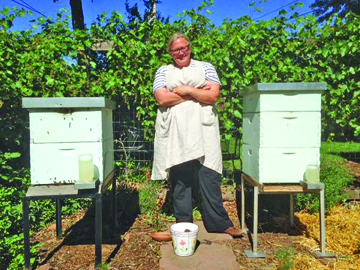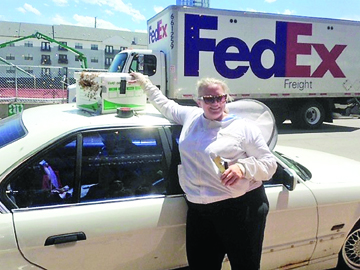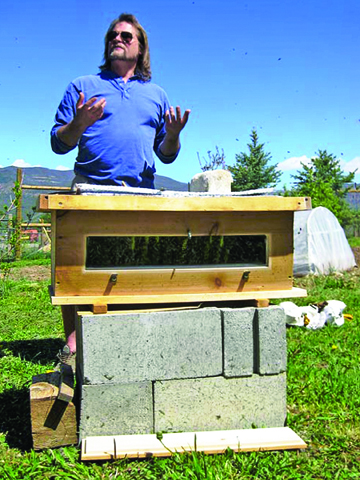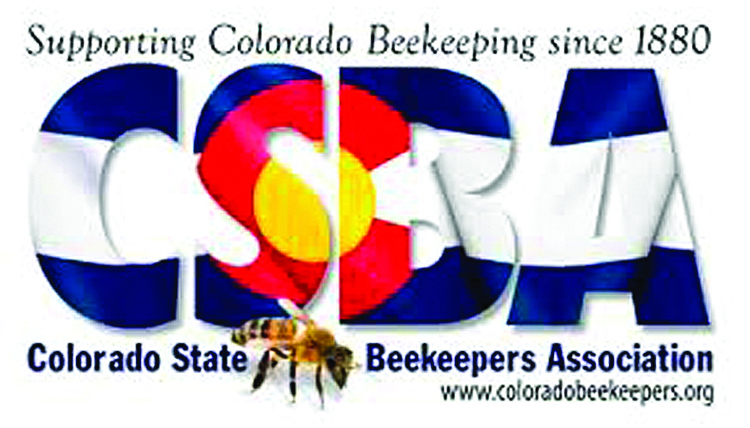by Ruthy Wexler

Beekeeper: Katherine Cornwell at home with her two hives of bees. Now a planning consultant, she worked for years as city planner for Seattle; Madison, Wisconsin; and — for eight years — the city of Denver. Madison, she says, “is the most like a bee colony. Itsdemocratic process was sometimes irritating as hell … If they did not want to do something, that city could not be moved. But when an idea was good, action was swift.”
While Denver continues to expand, the local bee population goes about its own complicated business — and a growing number of beekeepers are available to help when the two paths cross. On a recent sunny Friday, a large swarm threatened the pleasure of outdoor diners at Proto’s Pizza and so the construction crew across 15th Street called Katherine Cornwell, who is registered with the Swarm Hotline — and, it turns out, knows quite a bit about Denver’s expansion.
The small crowd attracted by Cornwell’s actions — gently scooping bees from the tree they’d settled on into an ordinary packing box atop her car — wondered how on earth she’d get the entire swarm into that box.
“See those bees near the hole of the box?” Cornwell explained. “See how they’re putting their butts in the air and fanning their wings? They’re letting the other bees know that the queen is inside.”
Fascinating And Wonderful
Katherine Cornwell didn’t know how much she would have in common with bees when she began studying them 10 years ago. All she knew was, she’d fallen in love.

Captured: Katherine Cornwell outside Proto’s Pizza on 15th Street, where she captured the swarm and explained to onlookers how she did it. The key was making sure the queen got inside the box, so other bees would follow.
“I was watching TV, which I rarely do,” she recalls. “This Haagen-Dazs commercial comes on — bees flying over a field toward a big succulent flower … then the screen goes blank. Words appear, ‘The honeybees are dying’ — and I start sobbing.
“I cannot explain to this day why it moved me so much. I was determined to learn more. I studied with Corwin Bell in Eldorado Springs — which ranks as one of the most lovely experiences of my life. I learned how fascinating and wonderful bees are. And I realized that bee colonies embodied principles I’d been thinking about in my own field, city planning.”
Bees And People

Expert: Corwin Bell, whom Cornwell studied under, teaches Bee Guardianship courses that show how bees, humankind and the natural world are connected and promote alternatives to conventional beekeeping. A computer animator and filmmaker, Bell has filmed hours of footage of honeybees. He travels the world to witness beekeeping under every condition imaginable.
As city planner for Denver from 2000-2008, Cornwell was inspired by her boss, the late Jennifer Moulton. “All around the city, wonderful things were happening. Civic Center, Stapleton, Central Platte Valley, Lower Downtown Denver …. Jennifer had such vision about the future, while preserving the past …”
Cornwell, who was co-author and project manager for Denver’s University Park Plan; East and West Colfax; the Main Street Zone District, and co-author of Blueprint Denver, now feels frustrated that current projects — like the widening of I-70 — do not take urban and environmental principles into account.
“As a city planner, I can tell you this project is counter intuitive. Widening roads in the urban core makes congestion worse …
“Development is now crafted behind closed doors,” Cornwell observes. “The so-called experts are just lobbyists, lawyers and spineless bureaucrats.
“And here’s where this relates to beekeeping. Bees and people are both very  complex. Both need communication, both need communities … But developers don’t trust citizens. Politicians don’t ask what citizens want. So wealthy individuals with high stakes interests are superimposing their vision on the people.
complex. Both need communication, both need communities … But developers don’t trust citizens. Politicians don’t ask what citizens want. So wealthy individuals with high stakes interests are superimposing their vision on the people.
Participatory Democracy!
“Bees have different roles, which they perform meticulously,” Cornwell explains. “The sentinel bee protects the hive, the nurse bee raises the baby bees, the scout goes out to find new food and new hives …
“When a scout finds a new potential hive, she doesn’t order everyone to go there. She comes back and communicates through a waggle motion danced in a figure eight pattern. Where she stops on the figure eight and how long she waggles indicates direction and distance of the new find. The number of times she repeats the dance correlates to the find’s degree of awesomeness, persuading other bees to check it out …
“If they agree, they’ll waggle dance about it too, until the whole colony decides as a group to go there.
“If that’s not participatory democracy, I don’t know what is!
“Denver,” she says, “is not behaving like a bee colony.”
Back To The Box
After a good hour — and a minor catastrophe, where the box’s lid blew off and Cornwell had to start all over! — the hive of bees all seemed to be collected and she entertained a few more questions.
“How did that swarm end up here?”
“Sometimes hives are disturbed by construction,” Cornwell said. “Which might have happened here. But usually they swarm because a new queen was born. The hive splits and the old queen leaves with half the colony to find a new home.”
“How do you get the queen inside the box?”
Cornwell smiled. “Providence, good luck, or chance. Usually it’s pretty easy. If the bees are just hanging from a small branch, I’ll clip it so the whole thing falls into the box.
“Today, the bees were clumped on a tree trunk. So I gently scooped them a bit at a time until I saw them acting like I had the queen, you know, fanning their butts in the air.”
Mission accomplished, Cornwell put the box inside her trunk and began the drive to an organic farm in Boulder where the bees will take up residence in a hive box with million-dollar views of the Flatirons.
For more information on swarm removal or beekeeping visit coloradobeekeepers.org or call 1-844-779-2337.
